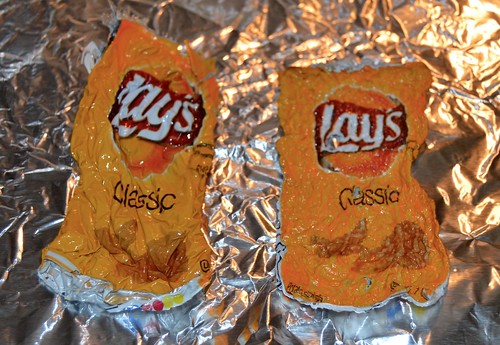
Kids are home for the summer and it's time to experiment, have some fun, and try out creative ideas. Why not sneak in some educational content as well? This fun experiment with snack bags shows how polymers work and how heat can affect molecules.

Materials:
- clean snack bag (aluminum inside, plastic outside)
- heat gun or oven
- foil - parchment paper recommended
- cookie sheet
- knife
- hot pad
Instructions:
We tried this experiment using two different forms of heat. Our first attempt, we used a HomeRight Heat Gun. Placing the snack bag on foil on top of the stove, we began heating at 100 degrees and continued to increase heat to almost 600 degrees. We used a knife to keep the bag in place, keep it flat, and flip it over as needed.
Our second attempt, we placed a cookie tray lined with foil and topped with the snack bag, into the oven at 450 degrees. This took about 5 minutes to see results.

The bag on the left is from the oven, the bag on the right was done with a heat gun.
Results:
Both versions used to heat the snack bags worked. We could control the heat gun version better. Our results did end up with holes in the final product. The oven version wasn't able to be controlled, resulted in a lumpier finished product.
Suggestions:
Using the oven process, we would add another layer of foil on top of the foil and then another cookies sheet to keep the end results flatter. We actually did this process but it resulted in a product with a ton of holes and stuck to the foil. Obviously, our heat setting was too high. With more practice, we could get better results.
Science behind the project:
The bags are made from a polymer that is stretch making the fibers long. Once heated, those fibers bend, wiggle, and shrink up. Molecules move at different speeds at different temperatures. Another example of heat and molecules would be a stuck sticker. They are hard to remove but once heated with a blow dryer or a heat gun, the molecules move making the sticker easier to remove. What other experiments can be done using this theory of heat and molecules?
















